|
|
Overview | |
Thysanoptera means "fringed winged" in Latin." Thrips are small slender
bodied winged or wingless insects. If the wings fully develop they are four in
number, are nearly equal, and are very thin with little venation and a lot of
hairs making a fringe around the edge. When present the wings are thin and
fringed, which is why they were named Thysanoptera. Though many are
winged they are often reluctant fliers with a predisposition towards thunder
storms as a suitable time of flight, thus they are called 'Thunder flies' or
'Thunder Bugs' in some places. They are perhaps the smallest of the winged
insects measuring between 1.5 to 3 millimeters. The largest species
occurring in the genus Phasmothrips. They have piercing sucking
mouthparts.
They are abundant in the tropical and temperate regions of the
world and approximately 5,000 species have been described. Thrips have an
economic importance, for some species may transmit plant viruses, reduce
productivity of plant, reduce flowers and fruits, or skelatonize (eat) plant
leaves. On the other hand, a few species prey on destructive mites and scale
insects, and a number may aid in the pollination of flowers and, indirectly, in
the formation of leaf mold. The larvae of thrips tend to be colored brightly
the adults range from whitish to brown or black. Adults have extensible
bladders on the tarsi of the legs, thus they are also commonly referred to as
bladder feet. The order Thysanoptera is divided into two distinct suborders.
The suborder Terebrantia contains four families and the suborder Tubulifera
contains two.
The order is divided based on the presence or absence of an
ovipositor (egg laying tube). The females of the Terebrantia have retained
the ovipositor whereas the females of the Tubulifera have undergone a
secondary loss with the abdominal (most posterior) segment fusing into a
tube. Fossil thrips are known from only as far back in time as the Jurassic
period, making them relatively modern as far as insects are concerned.
|
|
|
Identification |
Thrips have several defining characteristics that one may look for.
- asymmetrical mouthparts with right mandible lost
- two or three quiescent, pre-imaginal instars
- pretarsus with protrusible "bladder", which balloons out as leg makes contact with the ground.
- wing linear with long marginal setae
The principle morphological feature to look for is the asymmetrical mouth. In
which the left mandible appears much larger than the vestigial right.
|
|
|
Photographs |
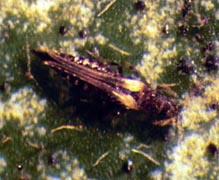
| 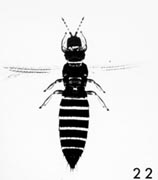
| 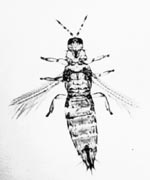
| 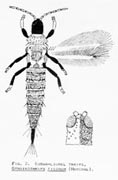
|
[Species: E. americanus.]
| [Species: Frankliniella fusca]
| [Species: Frankliniella trictici]
| [Species: Gynaikothrips ficorum]
|

| 
| 
| 
|
Thysanoptera damage
| Thysanoptera life stages
| Thysanoptera
| Thysanoptera damage
| Order: Thysanoptera
Photo Copyright
Tree of Life
|
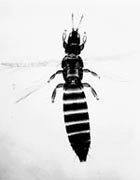
| 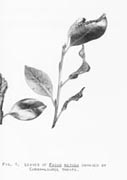
| 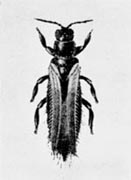
| 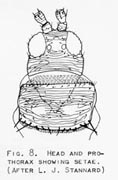
|
[Species: Limothrips cerealium]
| Thysanoptera damage
| Thysanopteran female
| Thysanopteran setae
|

| 
| 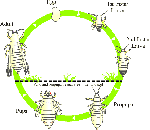
| 
|
Order: Thysanoptera
Photo Copyright
Rhodes University
| Species:Franklinothrips vespiformis
Photo Copyright
Mark S Hoddle
| Thrips Life Cycle
Photo Copyright
Mark S Hoddle
| Order: Thysanoptera
Photo Copyright
Bugpeople
|
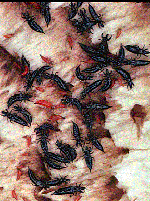
| 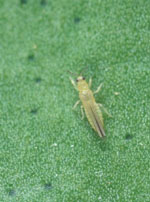
| 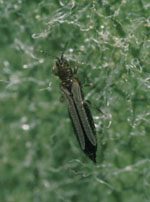
| 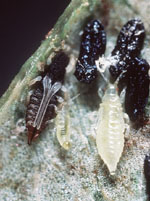
|
Family: Phlaeothripidae
Photo Copyright
Honey Bee Lab
| Species:Scirtothrips perseae
Photo Copyright
Mark S. Hoddle
| Species:Frankliniella occidentalis
Photo Copyright
Mark S Hoddle
| Species:Heliothrips haemorrhoidalis
Photo Copyright
Mark S Hoddle
|
|
|
|
Geographic distribution | |
Thrip's occurances are diverse in distribution. Families can be present on several continents. Aeolothripids
are widely distributed and occur in Europe, Asia, Africa, Hawaii, and North America. However, the only common
species of Merothripidae, Merothripidae morgani, is endemic to the eastern United States. Heterothripids occur
mainly in North America. Species in the genus Oligothrips occur mainly in Oregon and California. However,
the genus Heterothrips ia widely distributed across the continent. Thripidae is another family that is widely
distributed occurring in many temperate and tropical regions. Phlaeothipids occur in both Australia and North America.
|
|
|
Natural history | |
The development of thrips takes place in the egg, in two larval stages, during which all the immature
feeding occurs, and in one, two, or three pupal stages in which no feeding has been observed. Although
the changes that occur in pupae of Thysanoptera resemble those that occur in insects that undergo
complete metamorphosis, thrips belong to a group of insects that usually undergo simple metamorphosis.
Thrips main reproductive strategy is sexual reproduction. Parthenogenesis is known but rare. Also,
ovoviparity can occur in some members of the order Tubulifera. The males are shorter lived than
females, therefore, mating often takes place early in the life span. Eggs are elongated, oval to kidney
shaped, faintly to distinctly sculptured, and, as is the case in other minute insects, are proportionately
large, often occupying two or three abdominal segments of the female before laying.
Eggs are inserted into tissues of living plants, pushed under bark, inserted in or between flowers and
leaf sheaths or glued onto leaf or bark surfaces, etc. The strategy used to lay eggs depends on the
species and hence the presence or absence and the shape of the ovipositor. Eggs may take as many
as sixteen days to hatch. Although similar in overall form to the adult, the larvae of thrips are weaker
and simpler in structure. The long anal bristles characteristic of larvae may hold droplets of excreted
liquid that are deposited on leaf surfaces. The first stage is short (a few days); the second
may last up to many months when estivation or hibernation occurs. Depending on the family, the larvae may
transform directly into the prepupal form or may pass through an abbreviated intermediate form called the
primpupa.
Click here to see the Thrip life cycle.
The prepupal stage is of short duration (a few hours to several days) and gives rise to the final pupal
stage, of short or long duration, that eventually produces the adult.
Pupation takes place in the ground in earthen cells, in cocoons, or on a host plant. Some thrips, for
example, the ear thrips, have only one generation per year; others such as the onion thrips may have
several generations each growing season.
In regions having winter cold, thrips hibernate as adults or immature forms in detritus, hollow stems,
or in the ground. Those that perish with the cold are replaced each year by spring migrants from warmer
areas. In the tropics many thrips exhibit seasonal fluctuations, being more active in the wet than in
the dry seasons. Some thrips are sensitive to relative humidity. Larvae are generally found in shady
locations, on the underside of leaves or branches. Adults occasionally occur on the upper side of leaves
in bright light. Most thrips rest tightly against leaf veins or in crevices. They are primarily active
during the daylight hours. Thrips are preyed upon by many insects (including other thrips), mites, birds,
salamanders, and lizards. Heavy rains, winds, and dust are, however, probably as destructive to thrips
as are predators.
|
|
|
How to encounter | |
Thrips may be found in flowers, foliage, fruits, bark, fungi, and in debris.
Aeolothripids occur on various plants but are particularly common on the
flower heads of clover. Merothripids occur under bark, in debris, and in
fungi. Heterothripids can be found mainly in trees (e.g. oak, willow), in
flowers (e.g. azalea, jack-in-the-pulpit) or in the buds of the wild grape.
Members of the family Thripidae can be found attacking pears, plums,
cherries,onions,tobacco, beans, or grains. They are a large and diverse group
and different species target different portions of the plant. The presence of
dark colored spots of excreta adjacent to light colored feeding zones are
some typical signs of thrips damage. They may be collected by a variety of
means. For example, species found on vegetation may be collected by
sweeping.
|
|
|
Links to other sites | |
|
|
|
References |
- Borror J., Triplehorn C. A., and Johnson N. An Introduction to the study of insects. Sixth Edition.
Order Thysanoptera Saundera College Publishing Chicago, IL 350-356
- www.britannica.com
- www.earthlife.net
|
|
|
Acknowledgements | |
Aeneas Murnane, Biology major, University of Georgia, Athens.
Thanks to Sabina Gupta, Denise Lim, and Dr. John Pickering
for technical and web support in developing this page.
|
|
| Supported by | |
|
Following modified from University of Guelph
|
Top | See original
| &pull 20q v5.145 20180528: Error 301 Moved Permanently http://www.uoguelph.ca/debu/STEVEweb/html/Thysanoptera.htm |
|
Following modified from Texas A&M University
|
Top | See original
| &pull 20q v5.145 20180528: Error 301 Moved Permanently http://insects.tamu.edu/fieldguide/orders/thysanoptera.html |
|
Following modified from NC State University
|
Top | See original
| &pull 20q v5.145 20180528: Error 301 Moved Permanently http://www.cals.ncsu.edu/course/ent425/compendium/thrips.html |
ERROR -- Need to remove recursive link: http://www.discoverlife.org/nh/id/lucid/Insect_orders/html/Thysanoptera.html Lucid via Discover Life
Updated: 2024-04-25 11:47:21 gmt
|